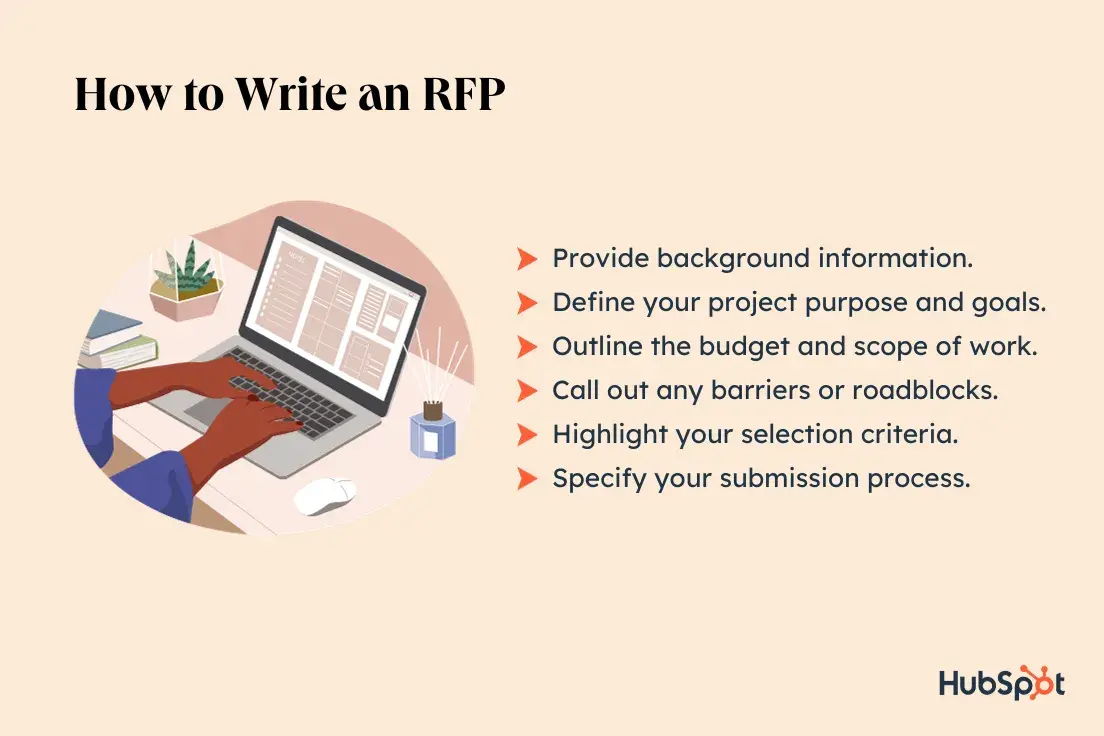
If I was reading a post about request for proposals (RFP), I’d want to get to the point … and fast.


All fields are required.
.png)
Click this link to access this resource at any time.
A request for proposal (RFP) is a written announcement designed to collect bids from vendors for a specific project. A good RFP clearly outlines the project details for both parties including what needs to be delivered, when, and for how much.
Since I struggle living in a world with a million acronyms, let’s clear up the difference between an RFP and RFI before we continue.
A request for information (RFI) is used by companies to get a sense of what solutions are available on the market. A request for proposal (RFP) invites vendors to submit bids so companies can make final decisions for a specific business project.
Here’s the TL;DR — If your business has a project and you need external support, and you already know what type of vendor you’re looking for, you can use an RFP to shop around.
When I worked for a small health communication firm, one of our government clients wanted us to create an educational video series for them.
I developed an RFP on their behalf to solicit proposals from video production companies since we didn’t have the capabilities to complete this work in house.
Hold on to this example — I’ll use it to walk you through the RFP writing process.

As a reminder, here’s the example we’re using for this walkthrough: AJC Health is developing an RFP on behalf of a government client, DoGoodGov, for educational video production services.
(The company names are made up, but the experience is real … I promise.)
Your RFP should always start with an introduction and overview of your business. This helps set the stage for potential vendors and allows them to better understand who they’ll be working with.
Pro tip: I like to keep this section brief. Just introduce your business, highlight your mission, and discuss the products and services you provide.
Example:
AJC Health is a health communication firm based in Washington, DC. Our mission is to empower teens and young adults to lead healthier lives.
For over 10 years, we’ve helped clients achieve their goals by providing marketing and communications services including campaign development, copywriting, and multimedia project support.
After you introduce yourself, provide an overview of the project. This is your first opportunity to describe what you’re hoping to accomplish and the areas of expertise you’re looking for.
I like to think of this section as a way to help vendors better understand your priorities so they can tailor their proposals accordingly.
Pro tip: I’d recommend keeping this section clear and concise. Focus on the purpose of the RFP, the type(s) of vendors you’re looking for, and your goals. You’ll have an opportunity later to provide specific details about the scope of work later.
Example:
The purpose of this Request for Proposals (RFP) is to invite businesses who specialize in video production, live action, animation, and multimedia for educational purposes to submit proposals to our company.
We’re currently seeking qualified vendors to support the development of a public health video series on behalf of DoGoodGov. Our goal is to build brand awareness, drive web traffic, and increase our YouTube marketing ROI.
In the last step, we described the project at a high level. This section is where you can get into the weeds a little bit. State your budget and describe the specific services you need.
For me, it’s helpful to compare this section to the “Job Responsibilities” section in a job description. Give a complete snapshot of what the role entails.
Pro tip: You can take various approaches when describing the services you’re seeking in an RFP, but I recommend incorporating bullet points or breaking up your information so that it’s easy for vendors to scan.
Example:
The budget for this project is $12,750.
The selected firm will be responsible for the ideation, production, and delivery of a three-part video series to educate teens and young adults about the benefits of living a healthy lifestyle.
Tasks include but may not be limited to the following criteria:
Here, you’ll want to mention any challenges specific to your project. This may include elements like limited resources or specialized requirements that the average vendor may not have or easily obtain.
This may seem counterintuitive, but I’ve found that this helps you eliminate unsatisfactory bidders and figure out which vendors have the skills to tackle those challenges.
Pro tip: It’s crucial to be transparent here. Otherwise, vendors may not fully understand the potential difficulties that may arise. This lack of knowledge could lead to delayed timelines, increased costs, or worse — an unsuccessful project.
Example:
As a federal entity, DoGoodGov requires all materials, including multimedia content, to meet the requirements of Section 508 Compliance. Vendors must have specialized knowledge in 508-Compliance for video production.
.png)
Fill out the form to get these templates.